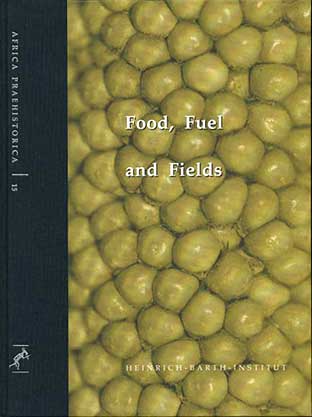
Africa Praehistorica 15, Köln 2003
FOOD, FUEL AND FIELDS.
PROGRESS IN AFRICAN ARCHAEOBOTANY
edited by Katharina Neumann, Ann Butler & Stefanie -Kahlheber
- 304 pp.
- 105 figures (line illustrations and bw. photographs)
- 45 tables
- hardcover, half linen-bound, size 21 x 28 cm
Until the late 1970s African archaeology has suffered from the lack of
basic data relative to the interaction between environmental change and
subsistence strategies, the transition to farming, and the rise of civilizations
and their economic background. Since then, numerous archaeobotanical studies
have been conducted to change this situation. The present volume includes
19 papers dealing with Egypt, Ethiopia, Libya, Kenya, Morocco, Namibia,
the Arabian Peninsula and the Canary Islands. It contains primarily the
revised and, in some instances, considerably expanded papers read during
the 3rd International Workshop on African Archaeobotany which was held
in Frankfurt in 2000. Presented are case studies on the plant remains
from archaeological sites and museum collections, as well as ethnographic
and comparative morphological and systematic investigations on living
plants.
Contents:
Domestication History of African Crops
Dorothea Bedigian: Sesame in Africa - origin and dispersal; Ann Butler: The Ethiopian pea: seeking the evidence for separate domestication; Elisabeth Hildebrand: Comparison of domestic vs. forest-growing Ensete ventricosum (Welw.) Cheesman, Musaceae in Ethiopia - implications for detecting enset archaeologically, and modeling its domestication; Katharina Neumann: The late emergence of agriculture in Sub-Saharan Africa - archaeobotanical evidence and ecological considerations.Archaeobotany of North Africa and the Canary Isles
Ahmed Gamal-El-Din Fahmy: Palaeoethnobotanical studies of Egyptian Predynastic cemeteries - new dimensions and contributions; Patricia Crawford: Weeds as indicators of land-use strategies in ancient Egypt; Barbara Zach-Obmann: 7500 years old imprints of Panicum turgidum in a Saharan potsherd; Ruth Pelling: Medieval and early modern agriculture and crop dispersal in the Wadi el-Agial, Fezzan, Libya; Jacob Morales: Islands, plants and ancient human societies - a review of archaeobotanical works on the prehistory of the Canary Isles.Wood for Fuel and Crafts
Barbara Eichhorn & Norbert Jürgens: The contribution of charcoal analysis to the Late Pleistocene and Holocene vegetation history of northwestern Namibia; Lydia Zapata Peña, Leonor Peña-Chocarro, Juan José Ibáñez Estévez & Jesús Emilio González Urquijo: Ethnoarchaeology in the Moroccan Jebala (Western Rif) - wood and dung as fuel; María Victoria Asensi Amorós: L'étude du bois et de son commerce en Egypte - lacunes des connaissances actuelles et perspectives pour l'analyse xylologique; Nahed Mourad Waly: Wooden objects from Ptolomaic and Early Coptic Periods, Upper Egypt.Out of Africa: Contacts with Asia
René T.J. Cappers: Exotic imports of the Roman Empire - an exploratory study of potential vegetal products from Asia; Marijke van der Veen: Trade and diet at Roman and medieval Quseir al-Qadim, Egypt. A preliminary report; Dominique de Moulins, Carl Phillips & Nadia Durrani: The archaeobotanical record of Yemen and the question of Afro-Asian contacts; Margareta Tengberg: Archaeobotany in the Oman peninsula and the role of Eastern Arabia in the spread of African crops; Dorian Q. Fuller: African crops in prehistoric South Asia - a critical review; Roger Blench: The movement of cultivated plants between Africa and India in prehistory.